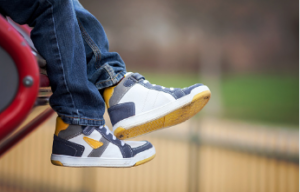School children can wear and tear significantly on their footwear, especially shoes designed specifically for school activities such as PE classes. A good quality shoe that fits correctly will help prevent foot problems in later years while encouraging natural movement from the start, particularly for athletes involved in sports activities.
If your school allows it, running school shoes could be better than black leather shoes for your child’s wear and tear.
Runners
 If your school uniform policy permits it, running shoes can make an ideal alternative to leather school shoes for your child. Running school shoes tend to be lighter and breathable and encourage a more natural running stride than leather ones; they also support your foot during running more effectively. However, these shoes should only be worn while running, not for everyday wear. Flipping their shoes upside down and inspecting wear patterns will allow you to determine whether your child is overpronating (collapsing/rolling inward), in which case it would be recommended that they get fitted for athletic shoes that offer greater built-in stability with deeper treading capabilities and built-in stability built right into them from day one.
If your school uniform policy permits it, running shoes can make an ideal alternative to leather school shoes for your child. Running school shoes tend to be lighter and breathable and encourage a more natural running stride than leather ones; they also support your foot during running more effectively. However, these shoes should only be worn while running, not for everyday wear. Flipping their shoes upside down and inspecting wear patterns will allow you to determine whether your child is overpronating (collapsing/rolling inward), in which case it would be recommended that they get fitted for athletic shoes that offer greater built-in stability with deeper treading capabilities and built-in stability built right into them from day one.
Young children’s feet contain 45 bones and require firm yet supportive shoes to develop strong, healthy feet. A quality pair will be the cornerstone for all physical activities. It can reduce pain from long school days and after-school adventures while helping your child avoid injuries and stay injury-free. Avoid cheap, no-name school shoes, which may increase your child’s risk of injury, and opt for black trainers with lightweight and flexible soles instead.
Cross Trainers
Workout shoe trainers, or workout footwear, are designed to support multidirectional movement during gym-focused training sessions. Furthermore, these footwear offers stability and cushioning – two essential components for weight-bearing exercises like squats and lunges in this environment.
Nike Air Max is ideal for high-intensity interval training sessions like those conducted by fitness writer Amanda Capritto but may not provide optimal performance over longer distances. If you plan on running more than 10 miles at once, specialised running shoes would give the best performance and avoid injury.
One key difference between cross trainers and running school shoes is the heel drop. Running shoes typically range from zero to 4-millimetre drops (the difference between heel height and forefoot height). At the same time, cross trainers are designed with more varied workouts in mind and usually feature higher, more substantial heel drops. They’re often heavier than their running counterparts to provide support when supporting lateral movement, and wider soles can also offer greater traction during dynamic moves on a basketball court or Zumba dance class.
Leather Lace-Ups
Lace-up shoes offer runners an easy solution for accommodating changing foot sizes without experiencing tightness due to too-tight laces. Lace-ups also allow runners to quickly adapt as their foot swells, eliminating uncomfortable sensations caused by tightened laces that become too restrictive during runs.
Subsequently, your left starting end of the shoelace should pass through the eyelet a second from the bottom, while its right ending end skips this eyelet and feeds into an eyelet one higher up on that same side of your shoelaces alternating straight across on the inside and horizontally across on the outside until lacing is complete. This pattern looks decorative while providing an alternative to standard crossing-over laces.
Clarks
Children need support from their feet as they run around schools, enjoy playtimes and attend long assemblies – modern, durable school shoes provide this support and can keep children’s feet healthy.
Clarks is an excellent brand that offers numerous options for school shoes for your children. Available primarily in black hue, these stylish yet practical school shoes come with either laces or elastic laces to make putting on easy.
Nike
Children’s feet need support from the ground up. By equipping themselves with appropriate footwear from birth, developing feet can assist children in building correct posture and gait to avoid injury as they age into adults. Each foot contains 45 bones, eventually fusing to become 26 larger bones when older, so they must receive correct support right from the beginning.